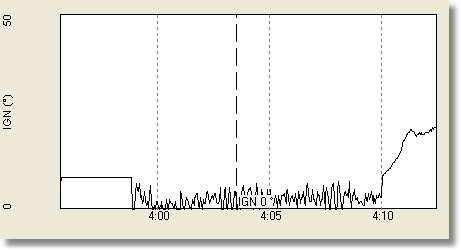Warning
Excessive ignition advance will damage the engine. The combustion pressure and load on the engine (especially bearing stress) increase dramatically if the engine is over-advanced. Do not believe the fallacy that 'more is better' for ignition advance. Too little ignition advance can also damage the engine by increasing the exhaust gas temperature, especially with turbo-charged engines. Do not rely on the knock sensor to retard the ignition timing if the engine detonates.
Tuning Ignition Advance at full load
The best way to determine the correct ignition advance at full load is by using a dyno. Generally for naturally aspirated engines it is safe to set the advance near to maximum power, with the aim being to run the least amount of timing possible. A good procedure is to tune for maximum power then retard the timing until you just start to lose power (around 1 hp). At all times monitor engine knock to make sure there is no detonation (even for a naturally aspirated engine). If pinging it audible or the ECU shows that the engine is knocking then it is advisable to abort the dyno run, retard timing/add fuel, and restart the run.
With forced induction engines it is important not to over-advance the ignition, otherwise the engine will be damaged in only a few seconds. Use conservative ignition settings, monitor the knock sensor and abort any dyno run if the engine shows signs of knock, pinging or detonation.
Tuning Ignition Advance at part throttle
Tuning ignition advance at part throttle is more difficult than full throttle because it is difficult to accurately determine the correct settings. In general the default calibrations are suitable for part throttle, otherwise an EGT gauge can be used to determine the best ignition advance.
Ignition controlled idle
When idling the ECU used ignition to control the idle speed. It is normal to see the ignition timing range from -10 to +15 degrees while idling.

Honda Knock Control
Honda knock control tables only offer a long term adjustment of estimated fuel octane, and do not use dynamic ignition timing control. For this reason the knock sensitivity has been reduced in the starting calibrations so that the knock control does not affect tuning.